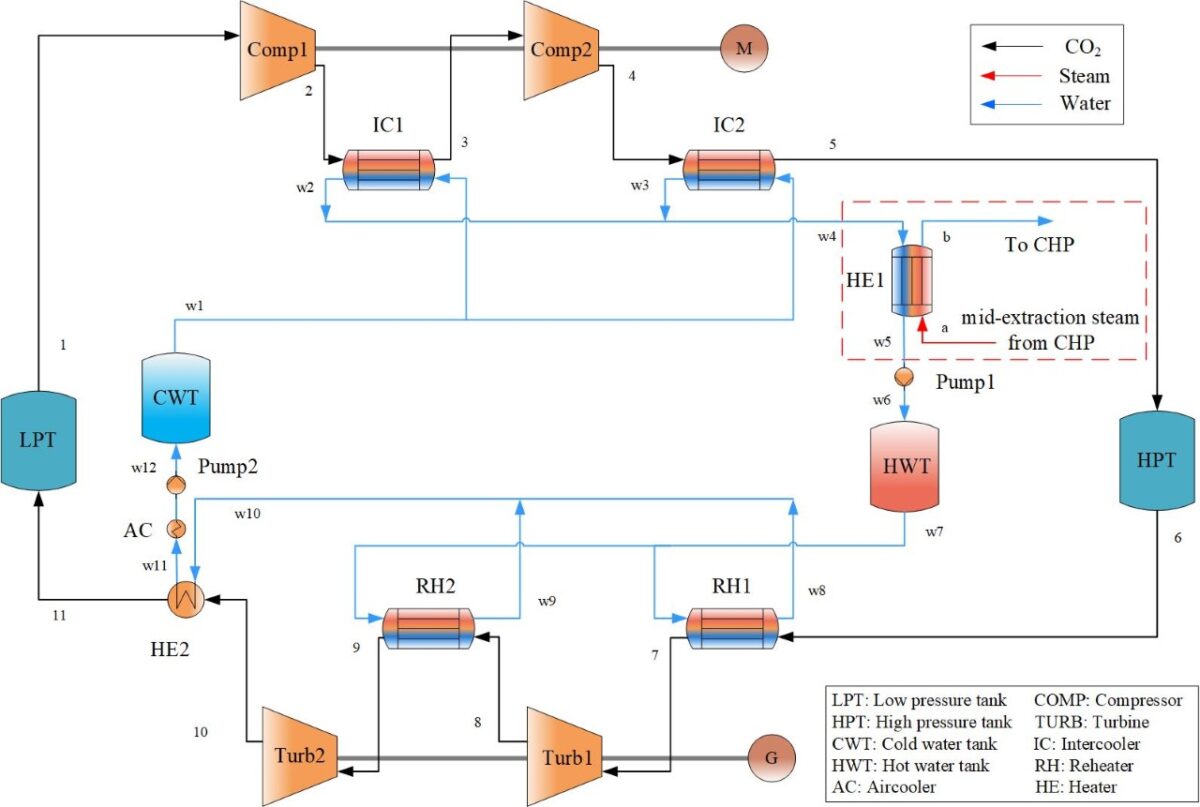Researchers at the Southeast University in China have investigated the possibility of coupling compressed carbon dioxide (CO2) with a combined heating and power (CHP) unit for the storage of solar and renewable energy.
The proposed solution is a closed-cycle system with a 600 MW CHP unit and a carbon dioxide energy storage (CCES) facility. It utilizes heat from the heat network backwater and operates through two stages of compression and expansion using water and carbon dioxide as working fluids, without exchanging mass with the external environment.
“During off-peak periods, the s-CO2 released from the low-pressure tank (LPT) is compressed in the compressor driven by the surplus generation capacity of the CHP,” the scientists explained.
The compressed CO2 then goes through an intercooler to store the compression heat in the water exiting the cold-water tank (CWT).
“After the two stages of compression, s-CO2 is stored in the high-pressure tank (HPT), and the cooling water is pressurized by the pump to be stored in the hot-water tank (HWT),” the scientists said. “The cooling water in the improved system absorbs additional heat from the mid-extraction steam before entering the HWT.”
During peak periods, the HPT releases sCO2, which is then conveyed through the reheater to recover heat from the HWT. It proceeds to the turbine to generate electricity. After this, the sCO2 is stored in the LPT, passing through the heat exchanger, while the water returns to the CWT.
The Chinese group used thermodynamic models to perform a thermodynamic and parametric analysis of the system and found that a system configuration adopting an unequal compression and expansion ratio distribution offered the best system performance. The researchers said that the best system configuration achieved a total exergy efficiency (TEE) of 35.96% and an energy storage density (ESD) of 1.54 kWh/m3.
The scientists presented the system in “Thermodynamic analysis and optimization of a compressed carbon dioxide energy storage system coupled with a combined heating and power unit,” which was recently published in Energy Conversion and Management.
“The performance and thermoelectric coupling characteristics of the proposed combined system under variable operating conditions must be analyzed in the future to investigate its ability to consume renewable energy,” they said.
This content is protected by copyright and may not be reused. If you want to cooperate with us and would like to reuse some of our content, please contact: editors@pv-magazine.com.




By submitting this form you agree to pv magazine using your data for the purposes of publishing your comment.
Your personal data will only be disclosed or otherwise transmitted to third parties for the purposes of spam filtering or if this is necessary for technical maintenance of the website. Any other transfer to third parties will not take place unless this is justified on the basis of applicable data protection regulations or if pv magazine is legally obliged to do so.
You may revoke this consent at any time with effect for the future, in which case your personal data will be deleted immediately. Otherwise, your data will be deleted if pv magazine has processed your request or the purpose of data storage is fulfilled.
Further information on data privacy can be found in our Data Protection Policy.